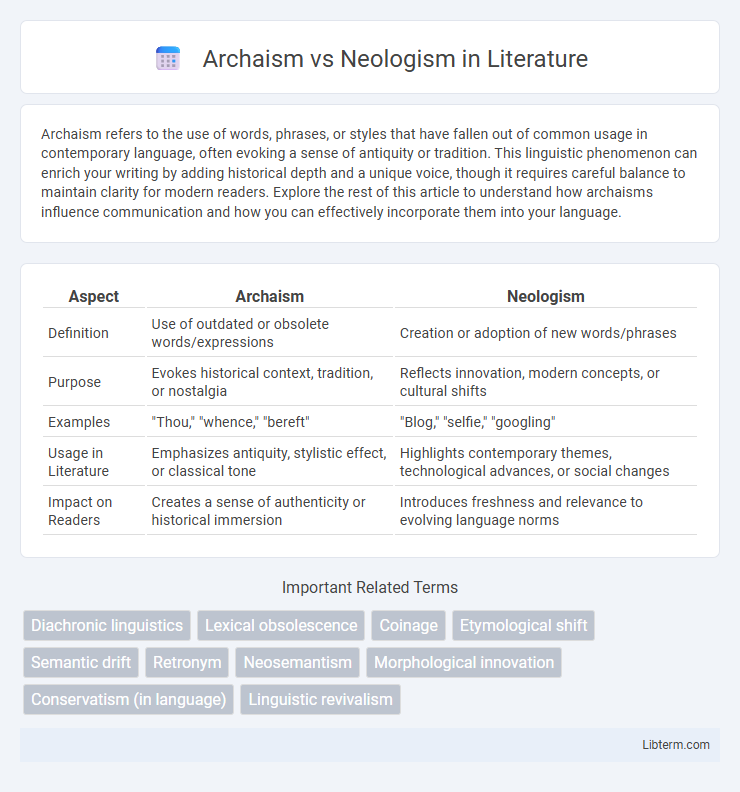Archaism refers to the use of words, phrases, or styles that have fallen out of common usage in contemporary language, often evoking a sense of antiquity or tradition. This linguistic phenomenon can enrich your writing by adding historical depth and a unique voice, though it requires careful balance to maintain clarity for modern readers. Explore the rest of this article to understand how archaisms influence communication and how you can effectively incorporate them into your language.
Table of Comparison
| Aspect | Archaism | Neologism |
|---|---|---|
| Definition | Use of outdated or obsolete words/expressions | Creation or adoption of new words/phrases |
| Purpose | Evokes historical context, tradition, or nostalgia | Reflects innovation, modern concepts, or cultural shifts |
| Examples | "Thou," "whence," "bereft" | "Blog," "selfie," "googling" |
| Usage in Literature | Emphasizes antiquity, stylistic effect, or classical tone | Highlights contemporary themes, technological advances, or social changes |
| Impact on Readers | Creates a sense of authenticity or historical immersion | Introduces freshness and relevance to evolving language norms |
Introduction to Archaism and Neologism
Archaism refers to the use of words or expressions that have fallen out of everyday language but are retained for stylistic or historical effect. Neologism involves the creation or adoption of new words and phrases to describe novel concepts or technologies. Both archaisms and neologisms highlight the evolving nature of language and its adaptability to cultural and temporal shifts.
Defining Archaism: Meaning and Examples
Archaism refers to the use of words, phrases, or expressions that have become outdated or obsolete in contemporary language but are still employed for stylistic or historical effect. Examples of archaisms include terms like "thou," "thee," "hither," and "whence," which predominantly appear in classical literature, poetry, and religious texts. Employing archaisms can evoke a sense of antiquity, formality, or nostalgia, enhancing the tone or atmosphere of the written work.
Neologism Explained: Origins and Usage
Neologisms are newly coined words or expressions that emerge to describe modern concepts, technologies, or cultural phenomena, often originating from scientific advancements, popular culture, or linguistic creativity. These terms gain traction through media, technology, and social discourse, reflecting evolving societal needs and technological progress. The rapid adoption of neologisms illustrates language's dynamic nature, adapting to contemporary realities and communication demands.
Historical Context: How Language Evolves
Archaism and neologism reflect the dynamic evolution of language across historical contexts, where archaisms preserve words and expressions from earlier periods, often rooted in classical literature or traditional speech. Neologisms emerge in response to technological advances, cultural shifts, and social innovation, introducing new vocabulary that captures contemporary experiences and concepts. This linguistic interplay illustrates how societies balance reverence for heritage with the need to articulate modern realities.
Impact of Archaisms in Modern Communication
Archaisms in modern communication evoke a sense of tradition and cultural heritage, enriching language with historical depth and stylistic elegance. Their deliberate use can create a distinctive tone, enhance literary expressions, or foster a nostalgic atmosphere, though excessive reliance may hinder clarity and accessibility. Balancing archaisms with contemporary language ensures effective communication while preserving linguistic diversity and historical awareness.
The Rise and Influence of Neologisms Today
Neologisms dominate contemporary language evolution, driven by rapid technological advancements and cultural shifts that necessitate new vocabulary to describe emerging concepts. Platforms like social media accelerate the spread and adoption of these terms, embedding them into everyday communication and popular culture. This rise challenges archaism, where older words lose relevance, highlighting language's adaptive nature in reflecting modern realities.
Cultural Significance: Old Words vs. New Words
Archaisms preserve historical and cultural heritage, reflecting the linguistic identity of past eras and offering insight into traditional values and social norms. Neologisms capture contemporary experiences and technological advancements, shaping modern communication and reflecting evolving cultural trends. The interplay between archaic terms and new expressions highlights the dynamic nature of language as a living record of cultural continuity and change.
Challenges in Understanding Archaisms and Neologisms
Challenges in understanding archaisms include their outdated vocabulary and obsolete syntax, which can hinder comprehension for modern readers unfamiliar with historical language usage. Neologisms present difficulties due to their rapidly evolving nature, lack of established definitions, and varying acceptance across different speech communities. Both require context-sensitive interpretation and linguistic adaptability to accurately grasp meaning and usage in contemporary discourse.
Archaism vs Neologism in Literature and Media
Archaism in literature and media evokes a sense of nostalgia and authenticity by using outdated language or expressions that reflect historical periods, enhancing the atmosphere and depth of the narrative. Neologism introduces new words or phrases, driving innovation and capturing contemporary culture, often shaping modern identity and enabling creative communication. The contrast between archaism and neologism highlights the dynamic evolution of language, balancing tradition with modernity in storytelling and media discourse.
Conclusion: Balancing Tradition and Innovation in Language
Balancing archaism and neologism in language preserves cultural heritage while embracing linguistic evolution, ensuring communication remains both meaningful and relevant. Archaisms enrich texts with historical depth and stylistic nuance, whereas neologisms address emerging concepts, technologies, and societal changes. Effective language use harmonizes these elements, fostering clarity and creativity across diverse contexts.
Archaism Infographic

 libterm.com
libterm.com